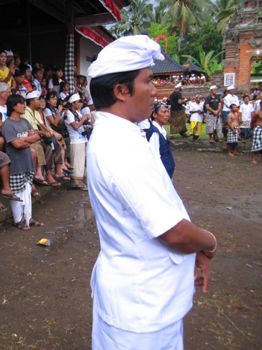Camera wielding spectators partake in their own form of ceremony at a temple ceremony in Bali
Siobhan Campbell
Image one. |
Photographers and their cameras have become such a common feature of the Balinese landscape that they have been appearing in Balinese painted depictions of island life since at least the 1930s. While early twentieth century images of topless women helped make Bali famous around the world, equally exotic twenty-first century snaps record the graceful deportment of legong dancers or women effortlessly balancing towering offerings on their heads as they negotiate busy streets. Temple ceremonies are staple fare and a small village in Klungkung, East Bali proves no exception as a curious mix of visitors clamber and jostle for the ultimate snap.
Twice a year on Kuningan, the tenth and final day of the period in which ancestors descend to the island of Bali, the residents of Banjar Timbrah in the village of Paksebali, Klungkung, East Bali conduct a ceremony known as Dewa Mesraman or ‘gathering of the gods’. Six palanquins, resembling sedan chairs, are constructed from bamboo to carry the gods from the temple Pura Panti down to the banks of the Unda river where they are bathed before being returned to the outer courtyard of the temple where they engage in a battle to celebrate their meeting on earth. Outside the village the ceremony is better known as Dewa Mapalu or ‘battle of the gods’ due to the seemingly aggressive nature of this godly encounter.
The following images were taken on 18 December 2010 as villagers and tourists gathered to enjoy the spectacle of young men in trance bearing the god figures of deities who had descended to the village. While the ceremony is a spectacle in itself, watching camera bearing spectators trying to capture the action while avoiding the crush provided an additional level of amusement.
1. Shortly before dusk most spectators had arrived at the village temple and were staking out a vantage point around the middle and outer courtyards of the temple where the gods were to engage in their battle.
 |
Image two. |
2/3. Led by a group of young boys bearing flags, women carried offerings into the middle courtyard of the temple, which were placed on the ground and offered to the deities to request their permission to conduct the battle.
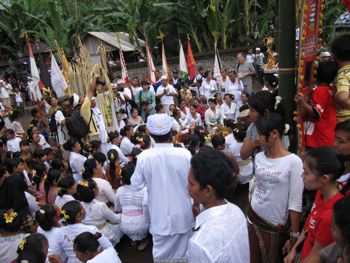 |
Image three. |
4. Men in trance carry a palanquin constructed from bamboo on which the god figures are borne as they must remain above head height.
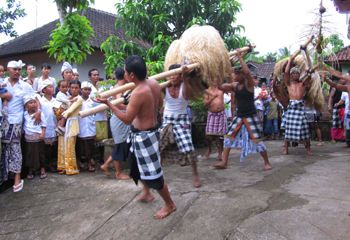 |
Image four. |
5. A pair of palanquins enter the middle courtyard and each circles the courtyard several times before running towards each other. The men on the left with red pom-poms are playing the cymbals as musical accompaniment and the tempo of their music contributes to the frenzy of the men in trance.
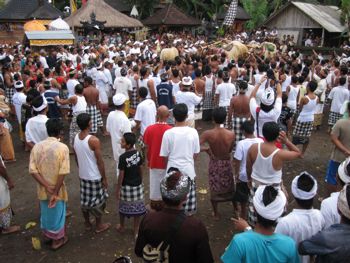 |
Image five. |
6. The clash as two palanquins meet in the gateway between the middle and outer courtyards.
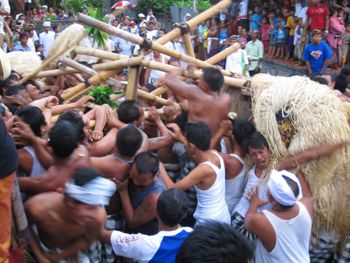 |
Image six. |
7. Bearing the palanquins is hard work and after almost an hour many of the young men are showing signs of exhaustion.
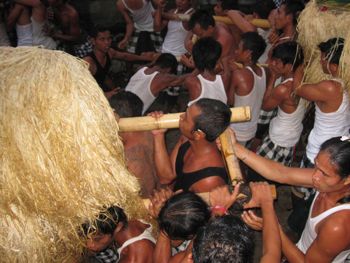 |
Image seven. |
8. As night falls the palanquins are guided through the temple gateway into the inner courtyard. Some resist entering the temple and have to be forcefully carried through the gateway. Once inside the bearers are sprinkled with holy water to bring them out of their trance.
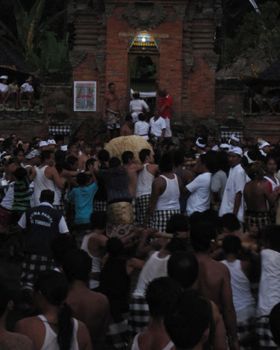 |
Image eight. |
Siobhan Campbell (siobhanlc@hotmail.com) is a postgraduate research student at the University of Sydney currently doing fieldwork in East Bali on the painting tradition of Kamasan village.

